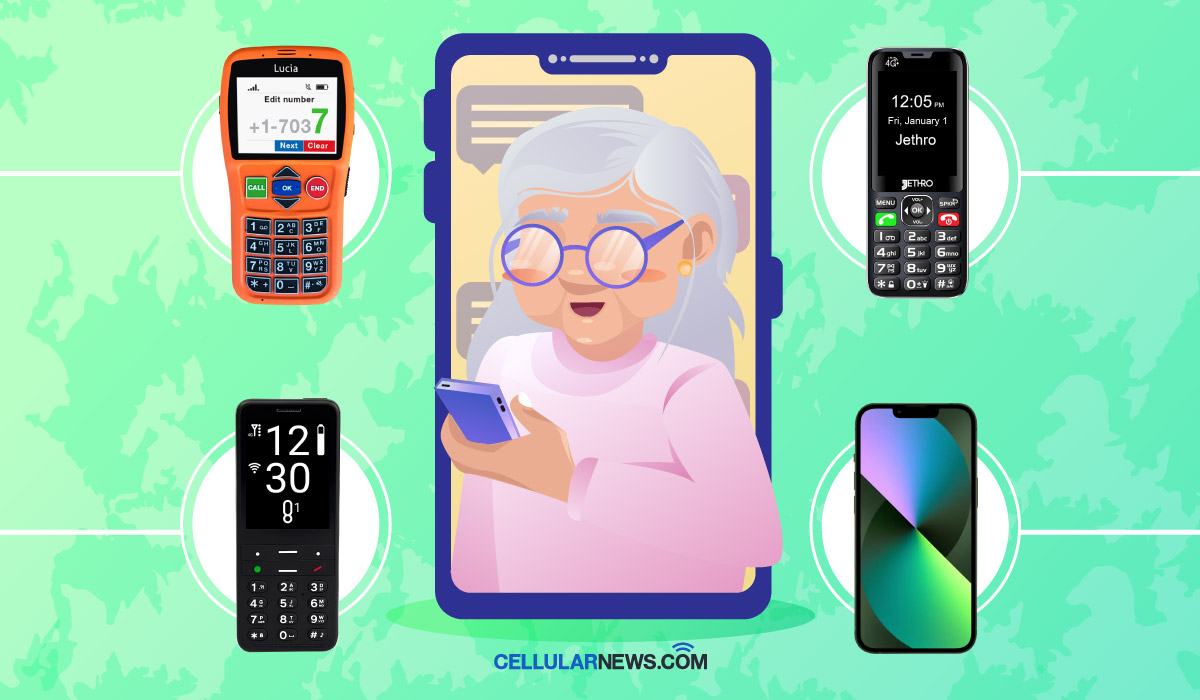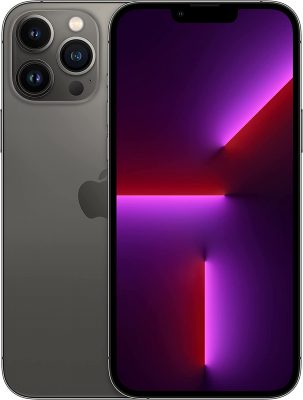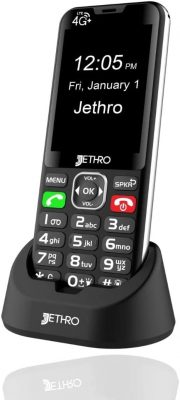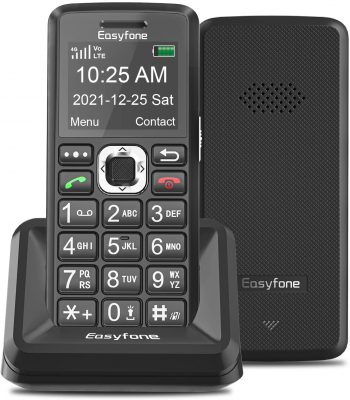Choosing the best cell phone for visually impaired seniors depends on what they will need. In recent years, more cell phones on the market have started adding features for the visually impaired. The available choices range from tailor-made feature phones to smartphones with AI assistants like Alexa, Siri, or Google Assistant. Both are great phones, but the choice will still depend on the special needs of the individual. Depending on the type of blindness, you will need to decide whether they can adapt to more demanding Android or iOS smartphones or stick with easier-to-understand featurephones. Regardless of what you pick, you would not have trouble finding the best cell phone for visually impaired seniors from our list!
Inside This Article
- Smartphones vs Featurephones
- Best Cell Phones for Visually Impaired Seniors
- How We Pick the Best Cell Phones for Visually Impaired Seniors
- Bonus: Apps for the Visually Impaired Seniors
Smartphones vs Feature Phones
Before we go into the list of the best cell phone for visually impaired seniors, we first have to differentiate between smartphones and feature phones. Smartphones are usually complicated touch-screen cellphones powered either by Android or iOS operating systems. These types of phones are pretty demanding and require their users to be a little tech-savvy to work their user interface (UI) and access their phone’s features. That said, the features they come with are pretty significant for seniors with visual impairment since these types of phones include assistive features like voice assistants, pill reminder apps, and a whole plethora of other useful features.
Feature phones or “dumbphones” are the opposite of smartphones. This is due to their simple and easy-to-use graphical UI, more limited functionality, and the lack of more “advanced” features like touchscreen displays or “apps.” In return, feature phones are more robust, energy-efficient, and usually have physical keypads. That last one is a big plus to those looking for the best cell phone for visually impaired seniors since they can physically touch the keys they need to press. That said, both types have their pros and cons, with the technical aptitude of their users as the only sticking point. Regardless of which type of phone you eventually get, both types have integrated features that help visually impaired seniors navigate, operate, and use these phones in day-to-day life.
Best Cell Phones for Visually Impaired Seniors

Now that we have gone over the types of phones, let us move on to listing the best cell phones for visually impaired seniors! To help you pick, we have listed down its brand, phone type, and hearing aid compatibility rating or HAC (if available).
Brand: Apple
Type: Smartphone
Headphone Jack: No
Pros
- 6.7 inch touch screen
- Has Voice Assistant (Siri).
- Equipped with Apple VoiceOver and Assistive Touch apps.
- Designed to work with hearing aids.
Cons
- It is expensive.
- Needs “Tech-savvy” users.
Yes, you have not read that wrong. Our premium pick for the best cell phone for visually impaired seniors and a good phone for the blind is the Apple iPhone 13 Pro Max. The reasons we picked it are simple. Not only does it have a gigantic 6.7-inch screen, but it also has a lot of assistive features that lets visually impaired seniors use them too.
The main feature the visually impaired would need is Apple’s VoiceOver on iPhone. This feature basically narrates everything happening on your screen — from changing the view between landscape and portrait mode to any text your finger may be hovering over. With VoiceOver turned on, you can also use different screen gestures to fully navigate and use your phone. Aside from that, VoiceOver and the 13 Pro Max are also compatible with Apple’s Siri virtual assistant, as it allows you to control your phone with voice commands instead.
This phone is also made for old folks with hearing impairment. It has an M3, T4 HAC rating, which means it won’t interfere with their hearing aid if they wear one.
Related: How to Enable Assistive Touch – A Tool For Those With Motor Skill Disabilities
Brand: BlindShell
Type: Feature phone
Headphone Jack: Yes
Pros
- Has voice narration and control to assist seniors.
- Has SOS Button.
- Includes FM and Internet Radio.
- Has M3, T3 hearing aid compatibility rating.
- 3000mAh battery (up to 96 hours on one charge).
Cons
- Moderately priced.
- Doesn’t access the Google Play Store.
BlindShell Classic II is a hybrid phone; it works exactly like a feature phone but runs on its own customized Android OS. Designed to be one of the best cell phones for visually impaired seniors, the BlindShell Classic II enjoys the best features of the two phone types. Not only will Classic II users enjoy the sizable keypad designed specifically for the blind, but they can also use apps like YouTube, Facebook Messenger, and WhatsApp at the same time.
Another good thing about it is its 1.5W speaker. While most cell phone speakers only put out 30mW of power, the Classic II’s puts out 1.5W. This difference lets seniors with hearing problems hear notifications, calls, and other sounds from this phone much better and clearer.
While it does not have AI voice assistants, it does have its own voice control app that works even offline (for selected languages) and lets you control the phone through voice commands. Another caveat is its apps. It is an Android phone, but it cannot access the Google Play Store. Instead, BlindShell has a small app catalog to choose from, with new additions from time to time. Overall, when it comes to price, features, and usability, the BlindShell Classic II is the best choice.
Brand: Jethro
Type: Feature phone
Headphone Jack: Yes
Pros
- It is affordable.
- Has an SOS Button (with up to 8 programmable contacts).
- Rated M4/T4 hearing aid compatible.
- Has 1800mAh battery.
- Has local customer support (1-888-509-6199).
Cons
- Has no voice narration and control or voice assistant.
- Might not be compatible with AT&T and other GSM carriers.
The SC490 is a feature phone from Canadian senior citizen-focused Jethro Mobile. A cell phone for visually impaired people, the SC490 model is made to be simple and is our most suitable value pick for the best cell phone for visually impaired seniors. It does not have any bells and whistles like voice narration or control. It also does not have an AI assistant and might not be fully compatible with GSM carriers. What it does have going for it is a decently sized screen with a big and evenly spaced keypad, M4/T4 hearing aid compatibility, and an emergency SOS button at the back. Regardless of its flaws, the SC490 is a good example of a feature phone for the modern-day.
Brand: Google
Type: Smartphone
Headphone Jack: No
Pros
- 6.71-inch curved screen.
- Has a voice assistant (Google Assistant).
- Has Google TalkBack (audible narration feature).
- Rated M3, T4 hearing aid compatible.
Cons
- It is expensive.
- Hard to find accessories for.
- Needs “Tech-savvy” users.
The Google Pixel 6 Pro is on our list for mostly the same reasons as our premium pick for the best cell phone for visually impaired seniors. With a 6.71-inch curved screen, it more than makes up for its lack of a physical keypad. It also has similar TTS and STT functions alongside the Google Assistant instead of Siri. The Pixel 6 Pro is also IP58 certified and has Google TalkBack, their version of Apple’s VoiceOver. If that is not enough, not only does its Android OS have more free and paid apps than the iOS. Another plus is how Google will also roll out the newest versions of Android OS to Pixel phones as they come out!
Brand: KAPSYS
Type: Feature phone
Headphone Jack: Yes
Pros
- Voice narration and control (TTS for more than 20 languages).
- Includes SOS Button.
- 1600mAh that lasts up to 200 hours on standby mode.
- It is FM Radio and Bluetooth 4.2 capable.
- Has HAC rating of M3/T4.
Cons
- Costly for a hybrid phone.
KAPSYS’ MiniVision2 is a simple and easy-to-use cell phone made from the ground up for the blind and visually impaired. While you can say a lot about its connectivity with Wi-Fi, 4G VoLTE, Bluetooth 4.2, and FM radio capabilities, that is not the best part of the MiniVision2+.
Similar to our best choice, the BlindShell Classic II, the MiniVision2+ also has voice narrate and voice command options included. These commands will let you place calls, make alarms, add notes, and enter new contacts by speaking to your phone. The KAPSYS MiniVision2+ is one of the best cell phones for visually impaired seniors you can get, especially if the best choice pick is a little too costly for you.
Brand: Lucia
Type: Feature phone
Headphone Jack: Yes
Pros
- Specially designed for the blind and visually impaired.
- Includes voice narration (TTS with 15 different voices).
- Has an SOS button.
- 3000mAh (10 hours with mixed-use)
- Has the highest HAC rating — M4/T4.
- Sound Boost Function (increases audio by +25db)
Cons
- It is costly.
- Does not include a voice command option.
Another feature phone designed from scratch, the Lucia V2 is definitively one of the best cell phones for visually impaired seniors. The Lucia V2 has an oddly shaped body that emphasizes its fairly large screen and its five differently-colored access buttons. At 5.47-inches tall, its well-spaced and defined keypad takes up most of its space and makes calling and texting easy on users. Other features include its 4G capability and a sound boost function to let you hear it better. Its main feature, though, is its voice narration which conveys everything happening to your phone. These include audible descriptions of text messages, remaining battery power, and even how to operate some of its functions.
Compared to the MiniVision2+, though, you have to manually control your phone instead of giving it voice commands. For those who need it, the Lucia V2 also has a customizable SOS button at its back to quickly call authorities, medical personnel, or family members in case of emergencies.
Brand: Lively
Type: Smartphone
Headphone Jack: Yes
Pros
- Enormous 6.22-inch screen.
- Voice Calling
- SOS Button (With a Lively phone plan).
- HAC: M4/T4
Cons
- Costly (when paired with a Lively phone plan – a requirement to use its full features).
- No voice narration and control.
- No voice assistant.
Lively’s Jitterbug Smart 3 is a low to mid-tier smartphone running its own custom version of Android 10. Similar to other Android-based Jitterbug phones, this Android version was made to simplify its controls and make it easier to navigate and use the Smart 3. Compared to the BlindShell Classic II, the Smart 3 is a touchscreen smartphone converted to have an easier-to-use UI instead of having a physical keypad.
The main advantage the Jitterbug Smart 3 has against other phones on this list of the best cell phones for visually impaired seniors is the Lively apps installed on it. Aside from needing a Lively phone plan, the three apps — Urgent Response, Urgent Care, and Lively Link — will make sure that you are taken care of when you need it. The first app works by pressing the phone’s SOS button, and operators will send required emergency services upon confirming your location. The other two apps will also get you in contact with medical professionals and your loved ones, respectively.
Brand: Lively
Type: Smartphone
Headphone Jack: Yes
Pros
- Includes Voice Assistant (Alexa).
- SOS Button (With a Lively phone plan).
- HAC: M4/T4
Cons
- Costly (when paired with a Lively phone plan – a requirement to use its full features)
The Jitterbug Flip2 is another one of Lively’s hybrid custom Android phones, based on the Alcatel OneTouch Go Flip. A pretty starter-tier smartphone, the Jitterbug Flip2 is basically an equivalent to our best choice pick, the BlindShell Classic II. What sets it apart, like other Jitterbug phones, are its Lively apps and services. Besides that, the phone is unremarkable either as a smartphone or a feature phone. Those wanting the best cell phone for visually impaired seniors should look to the BlindShell Classic II instead of the Jitterbug Flip2.
Brand: Easyfone
Type: Feature phone
Headphone Jack: Yes
Pros
- Affordable
- Wi-Fi, 4G VoLTE, and Bluetooth 5.0 capable
- SOS Button
- HAC: M4/T4
- 1050mAh battery
Cons
- Screen is small at just 1.8 inches.
- Not compatible with AT&T or CDMA carriers.
- No Voice Narration and Control.
- No Voice Assistant.
The T200 is another simple feature phone, this time by Easyfone. Equipped with Wi-Fi, 4G VoLTE, Bluetooth 5.0, and a neat charging dock, the T200 is a pretty good match for the earlier Jethro SC490. The main reason why this is far lower on the list of the best cell phones for visually impaired seniors compared to the SC490 is due to its smaller screen of just 1.8 inches. Apart from that, the Easyfone T200 is an affordable and decently feature phone that has a compact but well-defined keypad.
Brand: Tianhoo
Type: Feature phone
Headphone Jack: No
Pros
- It’s affordable.
- The 3.5-inch screen size is a plus.
- Has an SOS button.
- Has voice narration and control.
- Equipped with Google Assistant.
- Wi-Fi and 4G LTE capable
- FM Radio and Bluetooth 5.0 capable
Cons
- So-so build quality.
- Only works with GSM carriers like AT&T.
Another Android-based hybrid featurephone, Tianhoo’s EOS Flip 4G is similar to the BlindShell Classic II but worse. While it does have the same Android and physical keypad combination, the Tianhoo EOS Flip 4G has one glaring flaw since it only works with GSM carriers. It means that Verizon, Sprint, and other CDMA carriers are out of the picture when looking for a compatible phone plan. There is not a lot to say about this phone since it is pretty standard for a starter-tier smartphone. If you do have the money to get the EOS Flip 4G, we suggest going for the Jethro SC490 for a better deal instead.
Brand: Nokia
Type: Feature phone
Headphone Jack: Yes
Pros
- Budget-friendly phone.
- 1200mAh battery (up to 360 hours on standby mode)
Cons
- A small display at just 2.4 inches.
- No 4G, NFC, or GPS connectivity.
- No Voice Assistant or Text to Speech.
Our last pick for the best cell phone for visually impaired seniors is the tried and tested Nokia 3310 — its 2017 version at least. A revamping of the old classic, the Nokia 3310 3G could be the second coming of a new standard in mobile phones. While it may not have a large screen or fancy features like a touch screen, a voice assistant, or a narrator, it does offer something most “dumbphones” don’t — Wi-Fi functionality. This will allow users to surf the net at home while enjoying basic audio and video streams alongside the traditional FM radio.
We also have to note that both CDMA and GSM 3G sites have already shut down in the US. This means that the 3G function would not have any use in the US. Regardless, the Nokia 3310 3G is a pretty basic phone with a simple-to-understand UI and easy-to-read physical keypad, with a little added nostalgia factor for those who used the original. Those that want a similarly priced phone should look at our best value pick, the Jethro SC490.
How We Pick the Best Cell Phones for Visually Impaired Seniors
Picking a cell phone for seniors is already hard; more so when picking for visually impaired seniors. Given the right features, a simple mobile phone can help you take care of them while still allowing them to lead a semi-independent life. Here are some of the common features you should look for and the factors you should consider when picking the best cell phones for visually impaired seniors.
1. Voice Narration, Control, and Assistants
This means that the device verbally dictates what is being displayed on the screen. Examples include reading out your received text message or if your phone has switched to a landscape perspective. The control part means that the phone can be operated through specific voice commands either through an AI assistant app or the phone’s own specialized system.
When it comes to AI assistants, there are three main ones for this article, Google’s Google Assistant, Amazon’s Alexa, and Apple’s Siri. While made by different companies, they have similar capabilities that allow users to give set orders and help you operate your phone.
2. Text-To-Speech (TTS) And Speech-To-Text (STT)
These two features are usually part and parcel of voice narration, control, and AI assistants. TTS converts written text into audible speech, which is a big part of what voice narration does. Meanwhile, STT automatically converts your spoken words into text form for messages or other requirements. This feature is usually integrated with voice control and AI assistants which include voice command features.
3. HAC Certification
Those using hearing aids will know that their device has specific frequencies and wavelengths they operate on. Usually, cellular devices operate near similar frequencies which interfere with these hearing aids. HAC-certified cell phones are meant to denote phones that are more compatible with these hearing aid types (M3, T4, etc) and should interfere less with its operation.
4. IPXX
IP or Ingress Protection is an international standard (IEC 60529) denoting how protected a device is against solid and liquid intrusion. The first number after the “IP” shows its dust/solid intrusion protection, while the second number shows its water/water submersion protection. A higher number means better protection with IP69 as the highest rating for both. Devices with this rating are vacuum-tight and able to withstand high-pressure and high-temperature water jets.
5. Pricing
To make it easier for our readers, we have categorized each phone’s price into five categories. These five are expensive, costly, decently priced, affordable, and low cost in descending price order. As always with pricing, these may be subject to change but are originally based either on the phone’s manufacturer’s suggested retail price (MSRP) or its current price as of writing this article if MSRP is unavailable.
Bonus: Apps for Visually Impaired Seniors
Before we finish this list of the best cell phones for visually impaired seniors, we want to talk about a few apps and software suites that can help transform any smartphone into a blind and visually impaired-friendly one. Similar to what Lively does to their Jitterbug phones, companies like Synapptic and Project Ray have software that can transform your phone to help make it easier for visually impaired people to operate and use.
Aside from those software suites, there are also apps like Assistive Touch for Android on the Google Play Store or Apple App Store that make it physically easier to control smartphones for those with motor impairments.
Conclusion
There you have it — a list of the best cell phones for visually impaired seniors. Hopefully, you or your dear seniors found a few that they liked. That said, aside from the Jitterphones, the other phones on this list will need cell phone plans like Affinity Cellular’s plans that are perfect for senior users. It would be best if you also looked into getting a few mobile accessories for your chosen phone, like a waterproof pouch.











